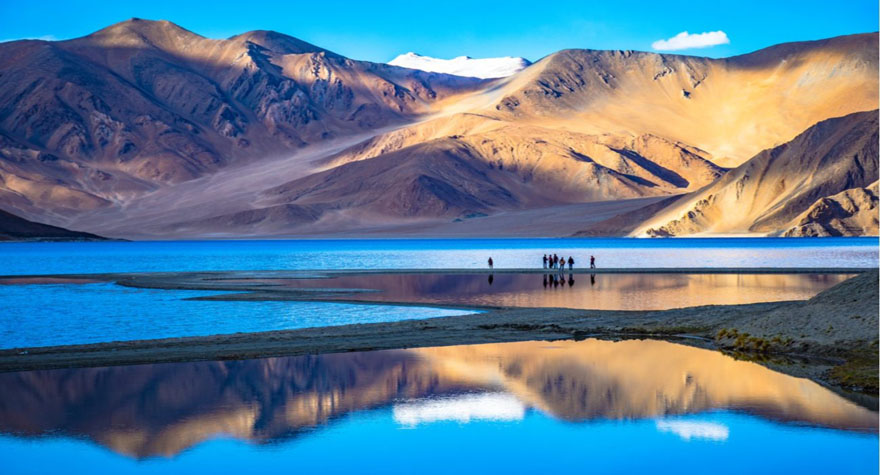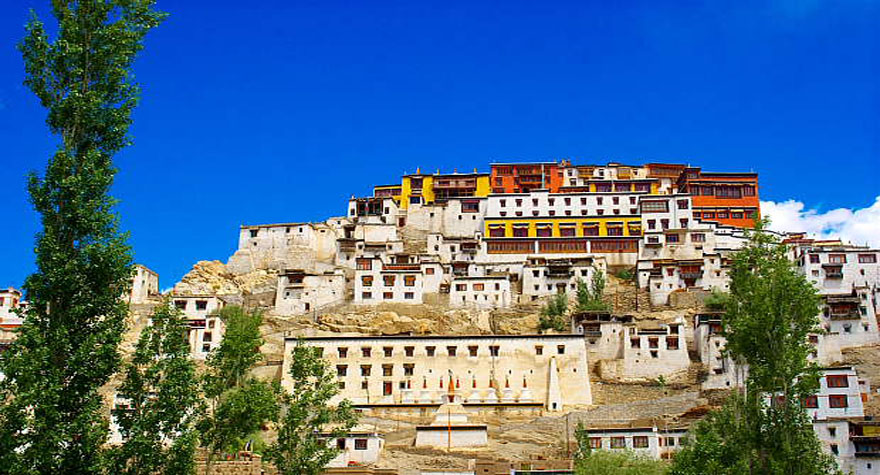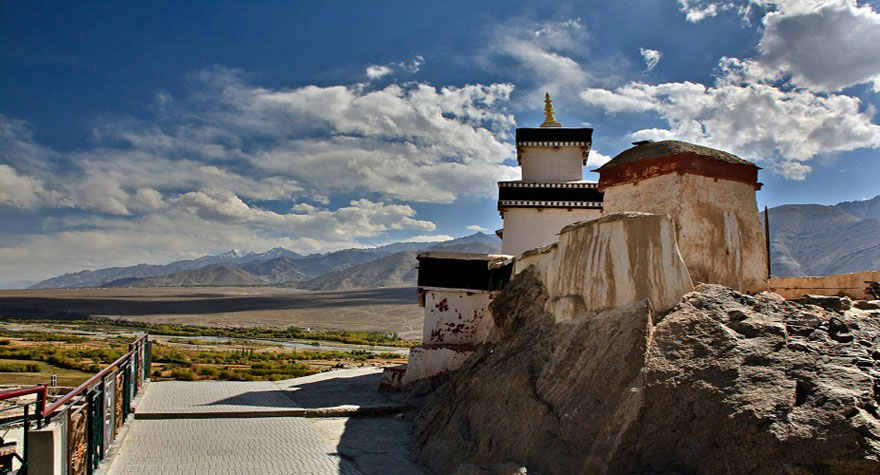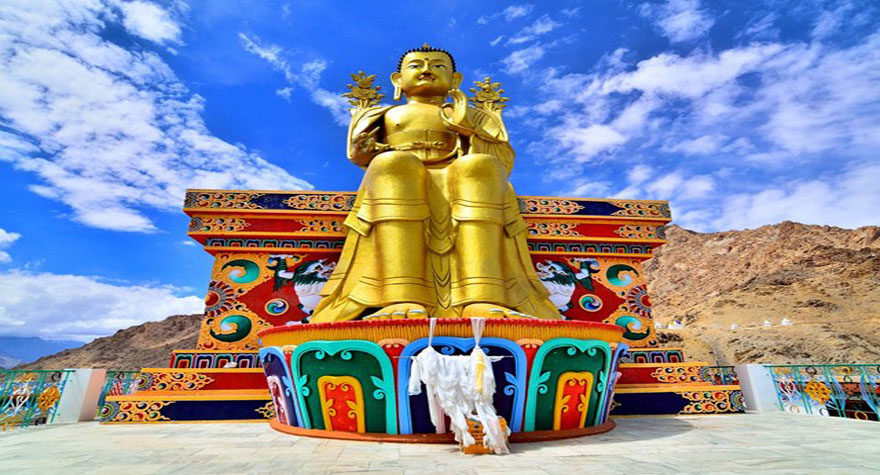About City
Leh Ladakh
"India's Own Moonland"
Ladakh is a union territory in the Kashmir region of India. Formerly falling in the state of Jammu & Kashmir, Ladakh was administered a union territory on 31st October 2019. Extending from the Siachen Glacier to the main Great Himalayas, Ladakh is a land like no other. Dominated by dramatic landscapes, Ladakh is known as the world's coldest desert.
Stunning Gompas (Tibetan Buddhist monasteries), fluttering prayer flags, whitewashed stupas, Ladakh is a riot of intricate murals and red-robed monks. It is said that only in Ladakh can a man sitting in the sun with his feet in the shade suffer from sunstroke and frostbite at the same time. With a culture similar to Tibetan culture, the people of Ladakh are friendly and welcoming to tourists.
Ladakh is an adventure playground for rafting and high-altitude trekking. Note that Leh Ladakh is inaccessible by road outside the summer months. The route passes close altogether from around October to May, and the only way to reach is by air. Chadar trek on frozen Zanskar river takes place in January to the end of February.
For those of us living in the constant confusion about the difference between these twin locations, Leh-Ladakh, here is something that might help you. Ladakh is divided into two districts: district Leh and district Kargil. The former district has a famous town, "Leh", and is a great tourist attraction because of its beautiful monasteries nearby, Shanti Stupa, cafes and Leh Bazaar defining the place's culture.
Places To Visit In Leh Ladakh
1. Pangong Lake
The most popular tourist attraction in Ladakh, Pangong lake is an endorheic (landlocked) lake situated at 4350 meters. Also known as Pangong Tso it is 12 kilometres long and extends from India to Tibet. Almost 60% of Pangong Lake lies in the Tibetan Autonomous Region. A unique feature of the lake is that it does not remain blue throughout the year or even the day, rather it changes colours from azure to light blue to green and grey too! It is famous amongst tourists as Ladakh lake, the spot where the Bollywood movie "3 Idiots" was shot.
2. Khardung La
Khardung La, also known as Khardzong La, is one of the highest motorable roads in India at an elevation of 5602 metres. It serves as the gateway to Shyok and Nubra Valley. Khardung La pass is a perfect getaway for adventure enthusiasts, peace seekers and mountain biking aficionados. An inner line permit is required to visit. It remains closed from October to May.
3. Nubra Valley
Nubra Valley lies in the union territory of Jammu & Kashmir, at a distance of around 140 Km from Leh. With arid mountains in the backdrop, it is famous for the Bactrian camel rides, orchards and monasteries. Surrounded by snow-dusted Himalayan mountains, it can be reached via Khardung La.
4. Sangam
Sangam is the confluence of Indus and Zanskar Rivers in Ladakh. The two rivers can be separately seen meeting at this point. While the Indus River appears as shiny blue, Zanskar River appears muddy green.
5. Shanti Stupa Ladakh
The Shanti Stupa is a white-domed Buddhist monument. It is a religious place for Buddhists as it holds the relics of Buddha, consecrated by the 14th Dalai Lama. It looks exceptionally beautiful during the full moon night.
6. Tso Moriri
Tso Moriri is the largest high altitude lakes in India, at an altitude of 4,595m. It is a twin to Pangong Lake. It is accessible only during the summer months and an inner line permit is required for visiting.
7. Magnetic Hill
The popular Magnetic Hill of Ladakh is a cyclops hill where vehicles seem to move upwards on the hill instead of rolling downwards. It is located 30km from Leh towards Kargil.
8. Hall of Fame Ladakh
Located at approximately 4 km from the main city, this glorified museum was built in memory of the brave soldiers who lost their lives fighting for India at the Indo-Pakistan war.
9. Thiksey Monastery
Thiksey Monastery is a Tibetan-style monastery located 20km south of Leh. The main highlight is the Maitreya Temple which houses a 15-metre high Maitreya Buddha statue. It is the largest such statue in Ladakh.
10. Zanskar Valley
Located in the Kargil district to the east of Ladakh (around 105 km) lies the bewitching Zanskar Valley. The semi-desert region is flanked by snow-capped mountains and sparkling clean rivers along with distinct flora and fauna. The easiest way of reaching Zanskar is from Kargil through Suru Valley.
11. Shey Monastery and Palace
Shey Monastery or the Shey Palace is an ancient monastery. It once served as the summer capital of Ladakh but is mostly in ruins now. Located on top of a hillock, it offers stunning panoramic views. The highlight of the monastery is 39ft tall Shakyamuni Buddha statue. A special permission needs to be taken to visit the monastery.
12. Stok Palace
Located around 15km from Leh, the Stok Palace is the summer home to the royal family of Ladakh and descendants of King Sengge Namgyal. It was established in 1820 by King Tsepal Namgyal and was opened to the public in 1980 by the Dalai Lama. The Stok Palace has been converted into a heritage hotel and houses the Stok Palace Museum and Temple.
13. Hemis Monastery
Hemis is a Buddhist monastery ranked as one of the wealthiest monasteries in India. It is most visited during the annual Hemis Festival, held every year in early June. The monastery is well-connected with motorable roads.
14. Rafting in Ladakh
Rafting expedition is done on Zanskar River, called the Grand Canyon of India, with high cliff like gorges at certain places. The Zanskar Rafting expedition is one of The best river trips in The world.
15. Pathar Sahib Gurudwara
Gurudwara Pathar Sahib is a beautiful gurudwara, dedicated to Guru Nanak Dev. It is highly revered as it houses a rock which resembles Guru Nanak's back. It is built at the site where he is believed to have vanquished a demon.
16. Kargil
Kargil lies near the Line of Control facing Pakistan-administered Kashmir's Baltistan to the west, and Kashmir valley to the south. Zanskar is part of Kargil district along with Suru, Wakha and Dras valleys. Kargil was at the center of a conflict between India and Pakistan in 1999.
17. Likir Monastery
The Likir Monastery is the oldest monastery in Ladakh, located around 52 km from Leh in the scenic Likir village. Belonging to the Gelugpa sect of Tibetan Buddhism, the main attraction here is a 75 feet large seated statue of Maitreya Buddha gilded in gold. There are also various paintings of guardian divinities, murals and thangkas that adorn the walls of assembly halls.
18. Alchi Monastery
Located in the Alchi Village of Ladakh, Alchi Monastery is a complex of Buddist temples of which Alchi Monastery is the oldest and most famous. Cemented on a flat ground unlike other monasteries in Ladakh, the traditional architecture of the monastery is a monastic complex which has 3 separate temples, known as Dukhang, Sumstek and the Temple of Manjushri.
19. Spituk Monastery
Spituk Monastery also called Spituk Gompa, is a Buddhist monastery located about 8 kms from Leh. One of the most dazzling monasteries in India, it houses 100 monks and a giant statue of Kali. It is famous for its collection of Buddhist objects of antique arms, icon, ancient masks and numerous Thangka paintings.
20. Diskit Monastery
Also known as Deskit/ Diskit Gompa, this is the oldest and largest monastery in Nubra valley, belonging to Gelugpa (yellow hat) sect of Tibetan Buddhism.
21. Bactrian Camel Ride
Nubra Valley is famous for the Bactrian Camel Safari. These camels are not even the usual ones that you must have seen in Rajasthan or in pictures. These camels having two humps were the major mode of transport to travel to silk route. These are now used for the safari in the region is hugely popular among the tourists.
22. Leh Palace
The Leh Palace is a 17th-century former royal palace that is converted into a museum. The highlight is the sweeping view of Leh and the surrounding Zanskar mountain from the rooftop.
23. Tso Kar
Tso Kar is a fluctuating salt lake located in the Rupshu Plateau of scenic Ladakh Valley. It is popularly known as the White Lake owing to the white salt deposits it leaves on the shores. Tso Kar Lake is the most peaceful and calm of the three high-altitude lakes (Pangong Lake and Tso Moriri) and also the smallest of the three. It is popular for bird-watching.
24. Hemis National Park
At an altitude ranging from 3,300 m to 6,000 m above sea level, this sanctuary is known to be the highest in the world as well as the largest park of South Asia. It is also a habitat to the rare Snow Leopards.
25. Chadar Trek
The Chadar Trek or The Frozen River Expedition is one of the most unique and challenging treks in India. The 6-day chadar trek across the frozen Zanskar River in Ladakh takes place during the latter part of January till the end of February or sometimes even in the first week of March, depending on the weather.
26. Hunder Village
Hunder is a remote village located in the Nubra Valley region, 7km from Diksit Monastery. It is known for its sand dunes, cold desert and bactrian camel rides. It is also home to forests of sea-buckthorn, which is a medicinal plant. Hunder is popular amongst trekkers.
27. Taglang La
The Tanglang La is a high mountain road located on the Leh-Manali highway just a few kilometers from Leh. It is at a height of 5,358 metres, is the second-highest mountain pass after Khardung-La Pass, and is also the 12th highest motorable pass. This popular spot in Ladakh is known for being the second highest mountain located in Zanskar range. The pass summit is breathtaking and is adorned by a number of prayer flags.
28. Turtuk
Turtuk is a small village located in Nubra Valley region of Ladakh, on the banks of Shyok River. It is an unexplored and offbeat place, opened to tourists only in 2010. The picturesque village with its tiny houses and fields is surreal. It remains cut off from Ladakh for 6 months during winter.
29. Hundur Monastery
Hundur Monastery is a hilltop temple located in the Nubra Valley, quite close to the Diskit monastery and Lachung temple.
30. Phugtal Monastery
The Phugtal (Phuktal) Monastery is a Buddhist monastery situated in the south-east part of Zanskar region in Ladakh. Situated at the mouth of natural cave on a cliff, it is one of the most isolated monasteries in the region, built around 2500 years ago. The Phugtal Monastery looks like a honeycomb from a distance. It is popular amongst trekking enthusiasts.
31. Lamayuru
Lamayuru is a tiny village that's popularly known as the Moonland of Ladakh. It is immensely popular for housing the Lamayuru Monastery, the oldest and largest monasteries in Ladakh. It is an ideal stopover between the Kargil-Leh route.
32. Stargazing
Leh-Ladakh, as already mentioned earlier, is a must visit place for all photography lovers – especially, Astro-photographers! The Major reason why Ladakh is a favourite among astrophotographers is because it provides clear night skies to complement the scenic beauty. Cities don’t generally have such pellucid skies owing to the pollution around.
33. Chang La Pass
Chang La Pass is a high mountain pass and one of the highest motorable roads in the world. The 15km long pass is especially popular amongst bikers. The roads are mostly paved and are driveable by any vehicle. Changla is open for tourists from Mid May to October.
34. Chemrey Monastery
Chemrey Monastery is a 400-year-old yet unexplored Buddhist monastery located approximately 40 kilometres (25 mi) east of Leh in northern India. It is known for housing a staggering statue of Padmasambhava (almost a storey-high)and a collection of ancient scriptures with the text emboldened in gold letters with the titles in silver.
35. Trekking in Ladakh
Know for its majestic and moon like terrains, Leh is attracted by many natural lovers and adventurous tourist. Some popular trekking routes include Spiti to Ladakh, Markha Valley trekking, Ladakh Zanskar trekking and the Nubra Valley trekking.
36. Namgyal Tsemo Monastery
Traveling to the Namgyal Tsemo Gompa makes you encounter the steep mountains and submerges you in its serene and spiritual folds. The monastery has long lured travelers seeking Buddhist experience but surprises them with something unexpected- the moon like, quiet and mystic expanse of Ladakh's landscape.
37. Lachung Temple
Located in the Nubra Valley, Lachung Temple is a religious pilgrimage found in the Diksit village. Besides housing some of the most colourful and narrative paintings, this temple is also one of the oldest holy sites in the region.
38. Druk White Lotus School
The Druk White Lotus School, also known as Druk Padma Karpo School, is a Buddhist cultural school located in the Shey valley, close to Shey Monastery and Palace. It is popular as the Rancho School from the famed Bollywood movie 3-idiots. It has become a popular tourist attraction, even though it is a not public tourist spot.
39. Shopping in Ladakh
For all those who like to fill their bags with souvenirs and local produce, the markets in Ladakh offers beautiful Tibetan jewellery, motifs, decorated carpets and woolen clothes.
40. Mountain Biking in Ladakh
Often termed the paradise of mountain bikers, Leh has thousands of tourists coming in every year to experience the thrill of driving on its steep slopes and adrenaline gushing paths.
41. MoonLand, Lamayuru
A peculiar landscape near Lamayuru on Leh-Kargil Road is the MoonLand. It is called so fondly, because the landscapes here are said to be like that of the moon.
42. Darcha Padum Trek
Located on river Bhaga, Darcha is a small Lahaul region in the Himachal district of Spiti. Whereas Padum is among the two primary capital cities of the Zanskar society. There are plenty of camping sites en route, spread across a variety of nomadic sites travellers would pass by.
43. Maitreya Buddha
Near the Diskit monastery in Nubra Valley stands a 32 meter tall statue of Maitreya Buddha facing towards the Shyok river. This statue is built with 8 Kg gold which was donated by the head of Gompa and was sanctified by the Dalai Lama.
44. Shyok Valley
Shyok Village is a hidden gem located in the Nubra Valley region, between Leh and Pangong Lake. Located on the banks of the Shyok River, this tiny hamlet is an offbeat location with only a few houses and families. It is the perfect place to slow down, breathe in nature and get away from the daily routine.
45. Chumathang Hot Spring
The Chumathang Hot Spring is a hot sulphur spring situated in a small hamlet along the Indus River called Chumathang about 138 km from Leh, Ladakh. The spring originates quite close to the river itself and is believed to have medicinal properties. Many believe that the mineral-rich water can cure one of skin diseases.
46. Thang Village
Thang Village, which is also known as Dhothang or Thanga Chathang, is a tiny village located in the Chorbat region of Leh. It is often referred to as the northernmost village of India. Thang lies on the Line of Control that divides India and Pakistan and offers spectacular views of the majestic mountains.
47. Hanle
Hanle, also referred to as Anle or Anley, is a historic and picturesque village situated in the Changthang region of Ladakh. It is visited magnificent views and its religious and astronomical significance. The main attractions here, besides the tranquillity, include a majestic gompa, an observatory as well as challenging roads or passes.
48. Puga
Puga Valley is situated in the Changthang Valley in the south-eastern part of Ladakh, about 22 km away from the Salt Lake Valley. It is a region of great significance known for its natural beauty and geothermal activities. Puga is also visited for its hot sulphur spring.
49. Hemis Festival
The Hemis Festival, a two-day festival hosted at the Hemis Gompa Monastery celebrates the birth of Padmasambhava, the founder of Tibetan Buddhism. Celebrated on the 10th day of the Tibetan Lunar month, the main highlight of Hemis festival is the gathering of the lamas around the central flagpole of monastery, where they perform the mystic mask dances (Chams) and sacred plays.
50. Ladakh Festival
The Ladakh Festival is an annual fiesta organised by the Jammu and Kashmir Tourism Department in Leh. Events such as folk dances, musical performances, mask dances, art and craft exhibitions, etc. form an integral part of this festival. It provides an excellent opportunity for the tourists to experience the culture and lifestyle of the people in Ladakh. A blend of Tibetan, Central Asian and Northern India; the Ladakh Festival is a week-long extravaganza that shouldn't be missed if you're visiting Leh-Ladakh.
51. Matho Nagrang Festival of Ladakh
The Oracle Matho Nagrang Festival is held at the Matho Monastery or Matho Gompa in Ladakh in the first month of the Tibetan new year. It is believed that two oracles, or Ronstang, inhabit the bodies of two specially chosen monks to predict the future of the village and individual villagers. Such traditions might seem unbelievable to the outsiders, but for the people living here, it's a way of life. Matho Nagrang Festival is one of the most important festivals of the Tibetan Buddhism Sakya School which like other Tibetan festivals, is celebrated with great pomp and show.
52. Dosmoche Festival
The festival of Dosmoche is one of the most popular festivals celebrated in Leh-Ladakh region. Falling right at the beginning of the Tibetan New Year, the festival is held in the majestic Leh Palace. Monks from different monasteries gather at the courtyards of the palace to perform Chams. "It marks the victory of the forces of good over evil. "
53. Losar Festival
The Losar festival of Ladakh is one of the major Tibetan Buddhist festivals that is celebrated with performances of traditional songs and folk dances of the region. The Ladakh area of Jammu & Kashmir witnesses an outburst of mirth in the form of festivities and high surged devotion on the occasion of Losar.
54. Watch a Chhams Performance
One of the most exotic things to do in Leh Ladakh is to watch the Llams perform the Chhams. The performance involves a dance drama executed by the Llams in colorful costumes. The whole event is filled with euphoria and is a delight to witness. These performances get especially popular during the Hemis Festival or the Ladakh Festival.
Food of Leh Ladakh
Leh is a multicuisine city serving Indian, Tibetan, Chinese and even Korean. The cuisine here exhibits tints of these foreign influences. Visitors must try out the local dishes which almost define the cuisine here such as Thukpa (noodle soup) Tsampa, known in Ladakhi as Ngamphe (roasted barley flour), and Skyu which is a heavy pasta dish with plenty of veggies as well as the very popular and delicious Momos which are steamed dumplings stuffed with vegetables or meat.
Drinks include tea, coffee, beer and Chang which is an alcoholic beverage drunk specially on festive occasions.
How to Reach Leh Ladakh
The most convenient way of travelling to Ladakh is by air. Kushok Bakula Rimpochee Airport of Leh is the main airport in Ladakh. It is connected by regular flights to all the major cities in India through New Delhi. The other way of reaching Leh Ladakh is by road. A bike trip to Ladakh is most popular amongst tourists for travelling to Leh Ladakh.
There are two road routes for bike trips to Ladakh -
Leh Manali Highway - Open from May to September. The 490km long route passes through Rohtang, Gramphu, Kokshar, Darcha, Baralacha La, Gata Loops, Lachulung La, Tanglang La, Gya and Karu.
Leh Srinagar Highway - Open from May to October. This route covers Sonmarg, Zozi La, Drass, Kargil, Mulbek, Lamayuru and Saspol and is 434km long. This route is at a comparatively lower altitude reducing the risk of severe high-altitude mountain sickness.
On reaching Ladakh, you might be asked to pay an environmental fee of around INR 200-300. You can keep the receipt to present it when applying for permits. Read more about how to get Inner Line Permit for Leh Ladakh.
Best time to visit Leh Ladakh
The best time to visit Leh Ladakh is from May end to the middle of July as the roads to Ladakh are open both from Srinagar Leh highway and Leh-Manali highway during this time. Also, there is a good amount of snow, especially on the Leh Manali highway. Another good time to visit Leh Ladakh is from the middle of September to October, when Ladakh is at its most beautiful. It is also possible to get good discounts during this time due to the lesser number of tourists.
It is advisable to avoid visiting Leh Ladakh during the monsoon from July end to August as the region is prone to landslides. Also, the Srinagar Leh highway and Leh Manali highway are full of sludge, making travel very risky.





